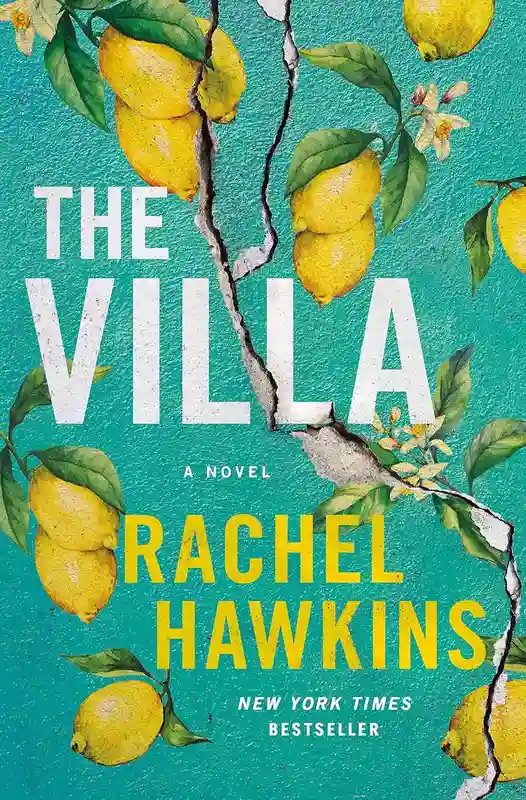This post may contain affiliate links. Read more here.

Note: the following discussion guide contains spoilers, as well as references to critical plot points and the conclusion of The Villa by Rachel Hawkins.
The Villa (2022) by Rachel Hawkins is a novel about close female friendships, fame, and creativity spanning different times (1816, 1974, and today). Hawkins, a popular author, mixes mystery, gothic, horror, and supernatural elements, focusing on women’s experiences.
The story explores the challenges of fame, drawing inspiration from the 1970s band Fleetwood Mac and the tensions among Mary Shelley, Percy Bysshe Shelley, and Lord Byron in 1816. It blends history and thriller, examining female authorship and tropes related to women’s roles.
The Villa by Rachel Hawkins
With 15 chapters, the novel follows Emily and her friend Chess uncovering Mari’s mysterious tale from 1974 to 1976. The narrative alternates between Mari’s third-person perspective and Emily’s first-person account. Set in Villa Aestas in Italy, the story touches on friendship dynamics amidst Emily’s failing marriage.
The book includes made-up excerpts from songs, novels, and articles, adding depth to the story. These excerpts, presented as real, question storytelling reliability. Emily and Mari, both authors, contribute to the complexity of identity.
In this guide we will go through the complete summary and ending explanation for The Villa by Rachel Hawkins.
Have a wonderful book club discussion! ✨
About the Author | Book Club Questions | Additional Recommendations
Summary | Characters Guide | Ending Explained
The Villa Summary
Emily and Chess, longtime friends with different lifestyles, embark on a creative journey together. Emily, struggling with her 10th installment of the “Petal Bloom” mystery series, lacks the fame and fortune enjoyed by Chess, a self-help book author known as the Chess Chandler brand. Chess invites Emily to join her at Villa Aestas in Italy to work on their respective projects.
Upon arriving at the villa, Emily and Chess uncover its unsettling past, marked by a famous murder in the 1970s. Emily’s intrigue intensifies as she discovers Mari Godwick’s book, “Lilith Rising,” recounting the events of the murder.
Mari, the partner of the victim Pierce Sheldon, lived in the villa in 1974. Emily and Chess, confronting their own unresolved issues, see the exploration of 1974 as an opportunity for bonding and creativity.
As the narrative shifts to flashbacks of London in 1974 and later Orvieto, Mari’s story unfolds. Mari, born into a family of intellectuals and artists, experiences a tumultuous upbringing. After her mother’s death and her father’s remarriage, tensions arise in the family.
Mari’s affair with musician Pierce Sheldon leads to a rift with her father. Living with Pierce, stepsister Lara, and friend Jane, Mari faces challenges, including the loss of her child Billy to fever. Lara’s affair with Pierce and involvement with famous musician Noel Gordon further complicate their lives.
Invited to Villa Rosato in Italy by Noel Gordon, the trio works on their creative pursuits. Mari focuses on her novel, and Lara, a budding songwriter, creates an album titled “Aestas.” The Villa becomes a backdrop for their intertwining stories, blending tragedy, creativity, and complex relationships.
In the present day, Emily and Chess engage in discussions about Emily’s past struggles with illness during her marriage to Matt and his desire for children. Both women are engrossed in their writing projects, with Emily secretly shifting her focus from the Petal Bloom series to a mix of memoir and nonfiction centered around the house. Emily, inspired by Mari’s presence in the villa, decides to share her new project with her literary agent and confesses the delay in the Petal Bloom mystery series.
In 1974, Mari faces unwelcome attention from Johnnie, a companion of Noel supplying drugs to the band. Johnnie, eager to join the music scene, shadows Noel, Pierce, and Mari in Italy. Noel takes Mari and Johnnie to see Pozzo di San Patrizio, a well in Orvieto.
During the visit, Johnnie overhears Noel criticizing him to Mari. Back in the present day, Chess secretly reads Emily’s work on Mari and the villa, praising its quality. She suggests they co-author it, but Emily, upset at the intrusion and angered by Chess reading her work without permission, rejects the offer.
As Emily delves deeper into Mari’s story, she realizes her copy of “Lilith Rising” contains clues to Pierce’s murder and the group dynamics of 1974. Emily discovers Mari’s diary near the carved initials in the villa, covering the events leading up to the murder. She keeps this discovery hidden from Chess.
Matt contacts Emily, hinting at her financial obligations related to the new book project, a secret known only to her literary agent and Chess. Determined to protect her career and finances, Emily dismisses Matt’s demands.
Suspecting Chess of betrayal, Emily confronts her about her communication with Matt. Chess denies any contact, and when Emily’s literary agent also denies informing Matt, Emily discovers Chess has taken her idea. Chess is writing about the villa and the summer of 1974, portraying Emily as a character with unrealized dreams. Emily, after reading Chess’s words, recognizes the location of the missing part of Mari’s diary.
In 1974, Pierce receives devastating news of his wife’s suicide, intensifying the turmoil in his life. Faced with the threat of losing custody of his child, Pierce’s world unravels. Noel, witnessing Pierce’s breakdown, advises Mari to sever ties with him, warning that Pierce’s destruction will extend to her. Johnnie and Pierce clash, with Johnnie accusing Pierce of ruining his wife and now seeking to harm Mari.
As the novel concludes in 1974, Mari completes her book, revealing in a flashback that she confesses to Pierce’s murder.
In the present day, Chess confesses to having had an affair with Matt, causing a bitter argument with Emily. Chess justifies the affair, claiming it was meant to help Emily escape a suffocating marriage. Despite their differences, Chess and Emily reluctantly agree to co-author the book. They hatch a plan to lure Matt to Italy and stage his accidental drowning in the lake. Their joint venture becomes a massive success.
In what seems to be a 1980 flashback, Mari confronts Noel before his death, hinting at her involvement in Pierce’s demise and Lara’s complicity. Mari tries to reconcile with Lara, who refuses to meet, haunted by the events of 1974. However, a 1993 flashback reveals that the 1980 events were Mari’s fictional ending in her novel “Lilith Rising.” The true version discloses that Johnnie killed Pierce for Mari, and she and Lara remained close until Lara’s death. Mari conceals this truth in the Villa.
Returning to the present, Chess discusses their next novel with Emily, who realizes that freeing herself from Matt has bound her to Chess in unexpected ways.
The Villa Ending Explained
So, what happens at the end of The Villa?
The final chapters of The Villa depict the murder of Matt in vague terms, highlighting how Chess and Emily become entangled through their shared secret and the nonfiction they create.
Mari, crafting her own imagined history where she saves Lara and Noel from mundane fates after murdering Pierce, has the last say. Emily withholds the conclusive pages of Mari’s diary, only revealing the alternative ending to Chess, where Mari foresees Chess and Emily seeking revenge. This fictional narrative, as Pierce dreamt, becomes the reality for Emily and Chess.
In the end, Emily pays the costs of fame, avoiding Matt’s controlling and profit-driven demands but becoming bound to Chess, who craves fame incessantly. Mari, connected to Villa Aestas and the transformative summer that shaped her, and as the memories of Pierce, Lara, and Noel persist in her mind, leaving a legacy to her fans, she becomes one with the deceased.
After Chess and Emily reconcile, Mari realizes that Chess spoke the truth about Matt being a threat to her life. Matt becomes a lingering presence, symbolizing one of the costs of fame for Emily. Mari, finishing “Lilith Rising” on the night of Pierce’s death, contrasts with Lara, who writes her masterpiece at the villa while the men in her life dismiss her.
The common antagonist for Mari, Emily, Lara, and Chess is the men who exert control or neglect, creating bonds the women struggle to break free from. The theme of fame comes with its costs, as does the pursuit of freedom. Chess, holding numerous secrets, binds Emily to her, revealing Chess as a multifaceted character with motives concealed until the novel’s conclusion, rooted in self-help principles.
On her final visit to the villa, Mari reconciles with the murder that liberated her, the pain that inspired a novel, and the circumstances that led to her mother’s death. As a counterbalance to the malevolent hauntings in Gothic novels, the memories and presences of Lara, Noel, and Pierce bring Mari comfort.
Mari emphasizes that Lara feels present in the house and that she can still sense Noel’s cologne, as if he just left the room. While she chooses not to acknowledge Johnnie, she acknowledges Pierce’s haunting presence in every step she takes.
These ghostly encounters enable Mari to write, and in 1993, as she faces her imminent death, she crafts both the fictional and true versions of the events in 1974. The two endings she provides for Pierce’s life cast Emily in a more honest light. Unlike Chess, Emily possesses the complete story of 1974 and chooses a path that aligns with the character Emma in Chess’s presumably unfinished self-help book.
Mari’s creation of Victoria symbolizes her quest for empowerment and freedom, Chess selects Emma to encourage Emily to take action, and Emily embraces Lilith’s path, aspiring for equality at any cost. In the end, the characters’ choices reflect a complex interplay of empowerment, freedom, and the haunting echoes of their shared past.
How did you like the ending of the novel? Happy reading! ❤️
